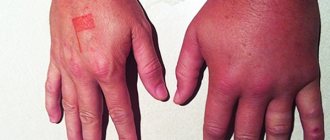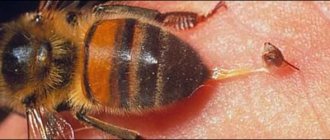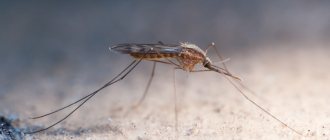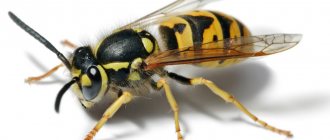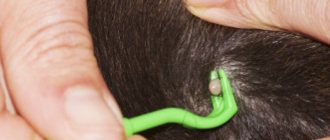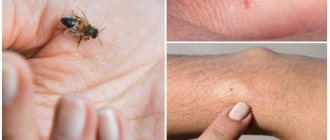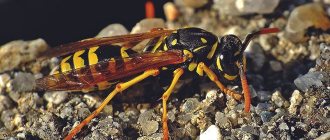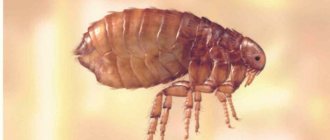A bit of Wikipedia
The horsefly is a large blood-sucking insect belonging to the order Diptera. Of the 1,600 known species, about 200 varieties are found in the CIS. If for males the food is plant nectar, then for females it is the blood of humans and animals.
Photo of a female horsefly
Females have a proboscis with a cutting apparatus. When an insect bites through the skin, a person experiences sharp pain. During a bite, the female injects a substance that prevents blood clotting , so blood flows from the wound for a long time.
Externally, the insect looks like a large gray fly, but with large eyes. The size of the body varies from 6 cm to 30 cm. The wings are decorated with a marble-colored mesh pattern. They prefer to fry and do not fly in the cold. Particular activity is observed before rain, but if there is wind, you will not see insects .
Sometimes you can hear that a gadfly has bitten, but this is a mistake, since the horsefly and the gadfly are completely different insects. They even differ in appearance, but the consequences of their bites are approximately the same.
Difference between horsefly and gadfly
Treatment
Recipes from traditional healers
Many folk remedies for gadfly bites are right under your feet. Medicinal herbs have anti-inflammatory, antimicrobial, antiseptic properties. This is exactly what is necessary to provide first aid for any insect bites. The most effective ways to prevent infection include the following folk remedies:
- Plantain leaves. The young plant must be crushed to a thick paste and applied to the bite site, and after the product has dried, the procedure should be repeated. Plantain contains biologically active substances that reduce the severity of pain and prevent the development of edema;
- Dandelion leaves. Fresh leaves need to be mashed a little, applied to the bite site and secured with a bandage. Dandelion exhibits antiseptic and anti-inflammatory activity and is able to stop the spread of infection.
You can do without medicinal plants. What to do if you are bitten by a gadfly and there is no medicine at hand:
- dilute a teaspoon of soda in a glass of water, soak a bandage in the solution and apply to the site of the gadfly bite;
- treat the damaged area of skin with sour cream or freshly squeezed tomato juice;
- place ice in a plastic bag, wrap it in a thick cloth and apply to the bite area for 10 minutes.
A compress of grated fresh potatoes effectively eliminates swelling of all layers of the epidermis. You can lubricate the bite site with low-fat sour cream, kefir, and valerian tincture.
Pharmacological drugs
If an insect attacks a person while hiking or gardening, you need to use disinfectant or antiseptic solutions that are in any first aid kit. How to anoint a gadfly or horsefly bite:
- 3% hydrogen peroxide;
- alcohol solution of chlorhexidine bigluconate;
- brilliant green solution;
- alcohol solution of iodine;
- a slightly pink solution of potassium permanganate.
Ethyl alcohol, and even regular vodka without additives, will help prevent the spread of infection and reduce the severity of swelling. The victim should definitely be given a tablet of any antihistamine:
- Suprastin;
- Tavegil;
- Loratadine;
- Cetrin;
- Zyrtec.
To quickly eliminate the symptoms of general intoxication (chills, fever, pain), you can use non-steroidal anti-inflammatory drugs. How to treat a gadfly bite with NSAIDs:
- for adults, take a tablet or capsule of Ibuprofen, Nise, Nimesulide;
- Give the child a teaspoon of syrup or suspension of Ibufen, Nurofen.
If there are no such products in the medicine cabinet, then regular Paracetamol in tablets or syrup will help reduce the temperature and relieve pain.
Everyone loves to relax in nature, swim in the river, and also fish or hunt. Rest in the forest is, of course, great, but it can be overshadowed by insect bites. The bite of the gadfly poses a particular threat. These are such inconspicuous gray flies, but their bite becomes very painful. However, despite this, they almost never cause harm, but they also do not go away without a trace.
It happens that the place where the insect bit a person begins to itch, bleed and hurt. In such a situation, we are talking about an allergic reaction that arose from the bite. This is all due to the substance that penetrated through the resulting wound.
Children should be more wary, because they have delicate skin, so bite marks take a very long time to heal. It may happen that the wound begins to fester, and this is bad.
Why is a horsefly bite dangerous?
The human body’s reaction to a horsefly bite can be different, it all depends on individual characteristics. What does a horsefly bite look like? For some, the bite passes with average sensitivity, for others allergic reactions appear, the bite site swells, lumps and boils form, and sometimes breathing problems occur.
If no reaction follows after a horsefly bite, a papule will form at the site of the wound, which will go away within two days. But if the matter is not limited to slight redness, then the swelling can completely cover the limb. In this case, there is a pronounced allergic reaction on the face.
Swelling after a horsefly bite
Important! If after an insect bite only a small papule appears with slight redness, and the only symptoms are annoying itching, then such a reaction is considered normal. If the swelling has spread throughout the entire limb or any additional sensations arise, you should seek medical help.
Basic information about horseflies
Horseflies are a type of midge (two-winged blood-sucking insects).
In total, there are about 4,000 species of such animals, 200 of which live in our area. The favorite habitats of horseflies are areas with abundant vegetation (forests, gardens, groves, crops in fields). But pests also thrive in urban environments. Compared to ordinary mosquitoes, horseflies are quite large blood-sucking insects. It is slightly larger than a regular fly. Horseflies have several stages of development. An interesting fact is that only female insects suck blood. Males feed on vegetation. At one time, the female sucks several times more blood than a mosquito.
You can distinguish a female by her appearance. Its body is almost 2 times larger in size than that of the male, its eyes are bulging, round, iridescent in multicolor. There is a bridge between the eyes.
Females feed on the blood of animals and humans. Without this food they will not be able to lay offspring.
The insect becomes active in the warm season. The largest number of parasitic flies is found in June-July. Horseflies love sunny, windless weather. You can't see them in rain or hurricanes. Parasites look for their victims based on two main signs - moisture and the smell of sweat. Insects have very developed jaws located in the proboscis. They use them to gnaw through the skin of a person or animal to extract blood. It is surprising that they sense the proximity of blood vessels. And they sting most often in those places where the skin is thinner and the capillaries are close to the surface.
There are cases where the parasite has bitten the eye (eyelid), head, or lip.
The area after a horsefly bite is always red. The bite itself is also sensitive. Only a sleeping person can miss it
Sometimes people mistake horseflies for ordinary flies and do not pay attention. In a short time, the parasite manages to choose a victim and tries to sting as quickly as possible
The first symptoms after a horsefly bite
What symptoms may appear after a horsefly bite:
- severe pain and burning in the affected area;
- swelling at the site of the bite;
- Strong headache;
- swelling, including of the entire limb;
- difficult to stop bleeding;
- unbearable itching;
Sometimes dirt or pathogenic bacteria get into the wound , which causes infection and suppuration. To prevent unwanted consequences, it is recommended to use various sprays to protect against midges. With proper treatment of the bite, the swelling disappears in a couple of days.
How a horsefly bites (photo of the mouthparts)
Gadfly bite
Quite often you hear: “I was bitten by a gadfly. What to do?". Firstly, I would like to immediately note that this is impossible. The fact is that almost all species of this insect do not have a piercing-cutting type of mouthparts. That is, even if they want to, they will not be able to bite through your skin. In principle, they don’t need this. Adult spiderworts (as gadflies are called in many areas) do not feed or bite! They have enough of the substances that they accumulated while they were in the larval stage.
But what really stings both people and animals (including cattle) are horseflies. For what? To get blood, which, like the same mosquitoes, they need to reproduce.
Why then do you still hear from many people (and even doctors) about cases where gadflies were bitten? This is explained by the fact that people confuse these insects. As a result, horseflies and gadflies sometimes act as synonyms. That is, this is the name of all flies that overcome people, livestock, animals, etc.
For reference! However, the fact that gadflies do not bite does not make them any less dangerous insects. These winged birds are carriers of various infections. They can also lay parasitic larvae, which cause significant harm to the health of their victims.
Possible complications after a horsefly bite
Sharp, unbearable pain is the least that a horsefly can leave its victim. Sometimes an insect bite leads to much more unpleasant consequences and complications. For example:
- Severe allergic reaction. The person’s condition noticeably worsens, there is severe swelling at the site of the bite, characteristic allergic symptoms appear (shortness of breath, swelling of soft tissues, nausea, vomiting, weakness in the body, etc.) Sometimes symptoms may appear only the next morning. Without proper treatment, the patient's condition will worsen.
- Non-healing wounds, suppuration, and boils form at the bite sites . Secondary infection occurs. To relieve itching, it is necessary to use an antiseptic, healing creams, and cold compresses.
- If the lymph nodes are enlarged , consult a doctor immediately, as in rare cases horsefly can cause the development of dangerous infections.
A strong reaction to a horsefly bite can occur in completely healthy people, but children are most susceptible to an allergic reaction. Hence the risk factors:
- young age (still immature immunity);
- weakened immunity (due to illness, age or after surgery, for example);
- allergies can also develop due to some medications that you have taken before;
- Chronic illnesses also increase your chances of getting a severe allergic reaction;
- alcohol or drug intoxication.
According to statistics, only 0.3% of people who are bitten develop a severe allergic reaction to a horsefly bite - how to relieve swelling in such a situation? To begin with, apply a cold compress, and then proceed based on the state of the body.
What to do if a horsefly bites a child? Children's immune system is still too weak and is not familiar with natural poisons and toxins. Therefore, the reaction of a child’s body to a horsefly bite can be much brighter than that of an adult.
In rare cases, the following symptoms are observed:
- shortness of breath develops;
- heart rhythm is lost;
- blood pressure may decrease;
- Nausea, dizziness and vomiting begin.
Unpleasant consequences of a bite
A wound after a bite from these dangerous insects rarely heals quickly and without a trace. A small bruise, redness, lump or papule may remain for at least a week. If the necessary measures have not been taken, then an abscess often forms at the site of the bite, which gradually increases and periodically hurts. The fact is that horseflies, along with saliva, inject pathogenic bacteria under the human skin.
The gadfly can even lay its eggs in the soft tissues of a person, from which larvae will appear in the course of further development. The body, of course, reacts very strongly to such parasites.
But it's not all that scary. There are also more dangerous consequences of bites. These include:
- Large swelling of soft tissues. They can be so strong that most of the limb swells - from the hand to the elbow on the arm, from the shin to the knee on the leg. At the site of the bite, redness and a rash similar to hives appear. This painful condition can be eliminated by taking an antihistamine. The greatest swelling often occurs with a bite to the head, lips, neck and eyes. In this case, the larynx and tongue may begin to swell, which prevents free access of air, causing suffocation and asphyxia.
- Infection with dangerous viruses. – carriers of tularemia, filariasis, anthrax, etc. Therefore, a bite and contact with these insects can potentially infect a person. What to do? Monitor your health, and if you notice strange symptoms, go to a medical facility immediately. It wouldn’t hurt to get tested to confirm whether there was an infection or whether you are completely healthy.
- Anaphylactic shock. If a person is severely bitten and a large amount of toxic substances enters the bloodstream, a rapidly developing allergic reaction that threatens life may begin. You need to act quickly and clearly. First of all, we call an ambulance and limit the intake of the allergen. After which we carry out anti-shock measures: we lay him on his back and free him from tight clothing, ensuring the supply of oxygen. The arriving medical team must administer an antihistamine and decongestant intramuscularly. If the pressure has dropped or there is a fainting condition, then an adrenaline injection is given.
Moreover, the most severe consequences of an attack by these flying insects occur in children under the age of 5 years. Their immune system is still developing, and the permeability of blood vessels is higher than that of an adult. Toxins from the gadfly's saliva quickly spread throughout the body, causing severe intoxication. Therefore, many experts recommend showing children to a doctor after a bite.
First aid when bitten by a horsefly
In the summer, especially near rivers, annoying insects often attack. What can be done at home, and how to provide first aid if a horsefly does bite?
Emergency help:
- First of all, do not touch or scratch the wound . Try to keep the bite area clean.
- To reduce burning and pain, it is recommended to apply some cold object or ice .
- To prevent re-infection, wash the wound with clean water and soap .
- If you are not allergic, you need to treat the affected area green or iodine .
- It would be a good idea to use a bactericidal patch .
It is important to know! When planning to relax in the lap of nature, it is worth taking with you a first aid kit, which will include first aid medications. This is cotton wool, a bandage, iodine, hydrogen peroxide, brilliant green, a bactericidal patch, an antihistamine if you are prone to allergic reactions.
How to prevent gadfly attacks?
It is much easier to protect yourself from the appearance of harmful insects than to treat numerous bites and injuries afterward.
Following basic precautions will protect you from unpleasant contacts with pests:
The fight against gadflies at home should involve installing mosquito nets on windows and doors. Dry herbs (wormwood or tansy) can be used as a deterrent; their oil solutions, which are used in aroma lamps, have a similar effect; when going outdoors, it is better to give preference to closed clothing, and also take care of insect repellent sprays and creams; such products not only protect against gadflies, they also repel ticks and mosquitoes
The color design of outfits deserves a separate discussion - they are attracted to bright colors, but they rarely pay attention to things in pastel natural tones; If you light a fire in nature, after cooking, try burning a bunch of field chamomile in the fire; the resulting smell does not cause hostility among people, but guarantees safety from gadflies.
If precautions still do not help prevent insect attacks, begin treatment for bites as soon as possible, because delay can cause negative consequences for your health
The article focuses on issues related to eliminating problems caused by hornet stings and which will be extremely problematic to deal with on your own without consulting a doctor.
What does a horsefly bite look like and how dangerous it is, how long does it last, consequences and allergies
The horsefly is a type of large fly that feeds on the blood of animals. Horsefly attacks on humans are relatively rare.
The bite of this insect causes burning pain at the time of sting and severe itching after it, accompanied by swelling of the surrounding tissues.
A horsefly bite is especially dangerous for allergy sufferers. The victim may develop a fever, weakness, and deterioration in health.
It usually takes 2-3 days for the swelling from a horsefly bite to subside and a person’s general condition to normalize.
After a horsefly bite, my leg hurts and it is swollen, what should I do, what should I treat and apply?
After a horsefly bite, the following measures must be taken: - prevent the spread of horsefly saliva components by pressing the bite site with a finger or a hard object; - wash the bitten area with water and laundry soap; - apply a cold compress to the affected area of the body; - treat the skin around the wound with an antiseptic solution - brilliant green, alcohol, hydrogen peroxide, chlorhexidine, etc.
In the following days, Fenistil-gel, Panthenol or Rescuer can be applied to the wound to relieve swelling.
How to treat a horsefly bite in a child, which doctor to consult
If a child has been bitten by a horsefly, the baby should be shown to a therapist or dermatologist. You can also go to the emergency room to provide first aid, and in severe cases, call an ambulance.
To treat the consequences of a horsefly bite, children are usually prescribed anti-inflammatory ointments - Hydrocortisone, Advantan, Sinaflan.
How to treat a horsefly bite with folk remedies, how to relieve redness, swelling and swelling
You can reduce tissue swelling when bitten by a horsefly using the following folk remedies: - applying a leaf of cabbage, plantain, black nightshade, mint or dandelion to the inflamed area; - rubbing the skin around the wound with aloe, onion or garlic juice; - applying a bandage thickly soaped with laundry soap to the bite site; - cooling the swelling with a cold object or a heating pad with ice.
If a horsefly bite oozes, what should you do to make it go away faster?
A horsefly bite, in which minor discharge is observed from the wound, can be treated with corticosteroid-containing balms and ointments, for example, Advantan. To speed up the healing process, you can also take antihistamines - Suprastin, Claritin and the like.
Horsefly bite during and during pregnancy
Only a doctor can give advice on how to treat a horsefly bite during pregnancy. A pregnant woman, immediately after a bite, should wash and disinfect the wound, apply a cold compress to it (to relieve itching) and consult a specialist.
Horsefly bite on the lip, under the eye
If a horsefly bites you on the lip or under the eye, you should immediately call an ambulance. Tissue swelling caused by insect bites in these areas can lead to difficulty breathing and cause equally serious complications.
Before specialists arrive, a hard, cold object must be applied to the bite site. Cold will reduce swelling and relieve itching.
Folk remedies for treating horsefly bites
If you are bitten by a horsefly and your leg swells, what should you do in such a situation, and how to relieve the swelling? To stop the bleeding and reduce the inflammatory process: swelling or hyperemia, it is necessary to use the juice of medicinal plants, which has anti-inflammatory and astringent properties. Such plants include:
- dandelion;
- peppermint;
- plantain;
- aloe juice;
- parsley;
- yarrow.
At home, you can wipe the affected area with lemon juice, garlic or onion.
Traditional Treatments
To relieve an allergic reaction, antihistamines are used:
- "Claritin";
- "Diazolin";
- "Allergozan";
- "Suprastin";
- for children - “Cytirizine”.
To eliminate itching, a solution of baking soda, mint-flavored toothpaste, and ammonia will help. Also, the affected area can be lubricated with “Hydrocortisone ointment”, “Advantan” . The Golden Star balm helps a lot, although it gives some people headaches.
How to protect yourself from horsefly bites
To protect yourself from horsefly bites, it is recommended to use personal protective equipment and know the habits of this insect.
- Horseflies prefer to attack during the day in good weather.
- When planning an outdoor recreation, clothes should be with long sleeves , shorts should be excluded, only jeans or sweatpants.
- To protect the stroller, you can use a special insect net.
- If you grind mint, wormwood or lemon balm and apply the juice to the skin, this will help drive away not only horseflies, but also bees, wasps and bumblebees.
In the end, let’s repeat the common truth: no bite, no problem !
Therefore, it is better to take measures to prevent the insect from biting you. If for some reason the horsefly still bites, do not panic. The bite site should be washed with clean water and treated with an antiseptic. To relieve swelling, use special ointments. If an allergic reaction develops, feel free to call an ambulance.
general description
People usually confuse horseflies with gadflies. But they have fundamental differences. The horsefly is a blood-sucking insect; its appearance is similar to a fly. While the gadfly resembles a bumblebee. In addition, he does not suck blood, he does not feed on anything at all due to his underdeveloped mouth. It accumulates all the nutrients for life in the larval stage. Males are only able to collect flower nectar. But during the breeding season, females bite animals in order to introduce eggs and, thereby, provide them with optimal thermal conditions for maturation. More often they attack cows, bulls, horses, and deer. Such cases rarely occur in humans.
Interesting fact: “Of all the species diversity of gadflies, only the human skin gadfly, which is found in America, is dangerous to humans.”
